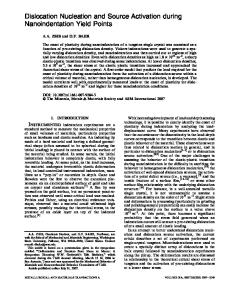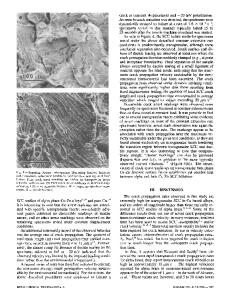Energy considerations regarding yield points during indentation
- PDF / 230,598 Bytes
- 7 Pages / 612 x 792 pts (letter) Page_size
- 50 Downloads / 391 Views
MATERIALS RESEARCH
Welcome
Comments
Help
Energy considerations regarding yield points during indentation D. F. Bahra) and D. E. Wilson Mechanical and Materials Engineering, Washington State University, Pullman, Washington 99164-2920
D. A. Crowson Nanomechanics Research Laboratory, Hysitron Inc., Minneapolis, Minnesota 55439 (Received 2 October 1998; accepted 10 March 1999)
Two experiments that probe the nature of the rapid transition from elastic to plastic deformation are described. The load, and therefore stress, at which this yield point occurs is shown to be relatively independent of temperature in an iron alloy. When stresses lower than those required to generate a yield point during loading are applied for times between seconds and minutes, yielding occurs while the sample is under an applied stress. The time to generate a yield point increases as the applied stress is decreased. The possibilities of dislocation glide loop nucleation, double kink nucleation, and dislocation breakaway from pinning points are examined. Only glide loop nucleation appears to match the experimental observations. Criteria based on the stress-volume requirements of glide loop nucleation and the stress field underneath an indenter are presented which qualitatively describe the experimental data.
I. INTRODUCTION
When an indenter tip is brought into contact with a sample under certain experimental conditions, the initial loading is elastic and is followed by a rapid onset of plastic deformation. Beginning with the work of Gane and Bowden,1 it was suggested that the stresses applied to the gold sample approach the theoretical shear strength of the material, even though it is likely that the stress field around the indenter will encounter a dislocation prior to the onset of plasticity. This was a significantly different phenomenon than had been suggested by Hertz in 1882. He proposed that yielding would occur when the applied shear stresses met either the Tresca or von Mises yield criteria.2 Recent work on the topic has suggested several mechanisms which may explain this behavior.3–6 The change in shear stress underneath the indenter tip has been shown to be an important parameter when examining the extent of deformation during the onset of plasticity.7 Other studies have focused on the initiation, rather than the propagation, of plastic deformation. Classic dislocation mechanisms covered by Hirth and Lothe8 suggest the shear stress to nucleate a dislocation glide loop is dependent on the energy required to generate a line length of dislocation. The free energy of a circular
a)
Address all correspondence to this author. e-mail: [email protected] J. Mater. Res., Vol. 14, No. 6, Jun 1999
http://journals.cambridge.org
Downloaded: 13 Apr 2015
dislocation loop of radius r is given by DG, where ∂ µ µ ∂ 2 2 n mb 2 4r 22 DG r ln s1 2 nd 4 r0 2 pr 2 bt 1 pr 2 g ,
(1)
for r . r0 where b is the Burgers vector, m the shear modulus, r0 is the dislocation core radius, t the shear stress, n is Poisson’s ratio, and g the stacking fault e
Data Loading...











